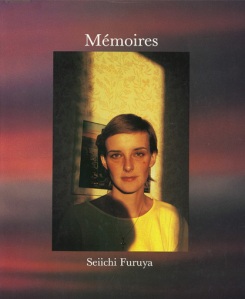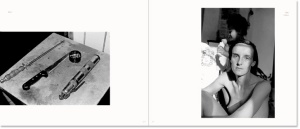Intimacy and photography, how much life can interact with a photographer’s work (and vice versa) : Seiichi Furuya.
Posted: August 31, 2013 Filed under: Photobooks, Photography 6 CommentsI am part of many discussion groups in various social network and I am very surprised that Seiichi Furuya’s name or books rarely appear in the discussions.
Like his famous Japanese photographer colleagues, Araki or Moriyama, his photo work is mainly composed of books. It is hard to know exactly how many books Araki and Moriyama have published (probably between 300 and 400 each), but Furuya’s publications are not so compulsive. He did not even published one twentieth of that and this is what make his work precious in my eyes.
Well, let’s start from the beginning. Seiichi Furuya is a Japanese photographer born in 1950 in Izu. After graduating from Tokyo Polytechnic University, he left Japan and came to live in Graz – Austria in 1975. There he met Christine Gössler and they married in 1978. They had a son in 1981. Amongst others, he worked as an interpréter and was also involved in photographic projects like Camera Austria, and introduced in the early eighties Moriyama, Tomatsu or Araki in Europe. Well, so far, you can start to think what is the point in talking about such privacy details ? The answer is very simple : because this is going to become his lifelong masterwork !
From the early days, he took pictures of his daily life, places he visited, portraits of his wife and son, friends… But pretty soon, in 1983, Christine was diagnosed schizophrenic and spent more and more time in a psychiatric hospital in Graz, untill October 7th 1985, when she killed herself . It is well understandable how hard it has been to overcome for Seiichi. So, as he kept on photographing his daily life, he started to publish in 1989 a series of book which some are called « Mémoires» which the subject was his life with or without Christine and his son. These books are :
Mémoires 1978-1988 (Camera Austria, 1989)
Mémoires 1995 (Scalo Books, 1995)
Christine Furuya-Gössler, Mémoires 1978-1985 (Korinsha Press, 1997)
Portrait (Fotohof, 2000)
Last Trip to Venice (self-published, 2002)
Alive (Scalo, 2004)
Mémoires 1983 (Akaaka Art Publishing, Fotohof, 2006)
Seiichi Furuya : Aus den Fugen (Akaaka Art Publishing, 2007)
Mémoires 1984-1987 (Izu photo, Camera Austria, 2010)
Some books may be missing, this list is not exhaustive.
All those books have their own value, and maybe we should consider the entire production as a piece of work. Their common point is probably the melancholy which is present all along the different books, but you can also consider that their subject is love and how much you can share with the other and what memories are made of. Well… life in fact! I will talk about three of them which have their specificities which I like a lot.
The first one is, chronologically, « Last trip to Venice ». It is a self published book in a print run of 529 copies. The book is about a trip the did in Venice, in February 1985, between her release from the hospital and her suicide. When you know the story, it becomes a haunting book. Furuya shot three rolls of films and one was already used so he got superimposed photographs, like if he/they were already looking back in time. A stunning book showing the last time they spent together, and you cannot avoid, when reading the book, to perceive the death, standing at the end.
The second one is « Mémoires 1983 ». This book is the diary of the year 1983, when Christine entered the hospital. The book alternates photographs and texts. The texts are extracts of Christine’s diary and the relation with the photographs makes the strenght of the book, like when Seiichi took pictures of animals in a laboratory which evokes the alienation of Christine in the hospital. Or some other photographs when Christine is laying on the floor acting like a dead corpse ! You can see the prefiguration of the years to come in some phoptographs. Here again, the death is standing by their side.
The last one is « Mémoires 1984-1987 ». It has been recently published and the difference with the others is that it shows pictures chronologically before and after her suicide. As in the previous books, we feel the death coming, but we stay with the author, who keep on photographing, to discover how he could overcome his distress. This book is a compilation of all the other books (352 pages) and maybe, if you have to buy one, this is the one ! The book is beautifully printed with a convenient size of 20 x 25 cm which allows the reader to really appreciate the photos.
Approximately in the middle of the book, you discover, first, the last letter that Christine wrote to her doctor, in which she explains her will to start a new therapy and finally accepting her illness (this letter was never sent because of bank holidays, so it remains in Seiichi’s hands), and a few pages later, a contact sheet with a caption : Postdam, October 6, 1985-Falkenberger Chaussee 13/502, Berlin-Ost, October 7, 1985. This was the day when Christine threw herself from a window on the 9th floor. In the middle of the contact sheet, you discover a view from the window with the dead body of Christine laying on the ground. On the following pictures, you see a view from the ground with a cover on the corpse, and a policeman beside. This contact sheet returns us the question of the attitude of a photographer (in this case Seiichi Furuya) who decided in such circumstances to take a picture of the dead body of his wife. I have absolutely no explanations. Maybe it was just a matter of survival for him to hide and/or look for protection behind his camera ? Maybe he needed to record the awfulness of the moment ? This enlarged contact sheet is part of a series called « the journey » which comprises 6 enlarged contact sheets of photos shot during the year 1985.
If you are looking for a cheap book as an introduction, your choice will go to « Mémoires 1995, published by Scalo which can be found for a couple of euros on internet.
All images copyright Seiichi Furuya and the publishers. Can be removed on request.





















heavy contact sheet
Thanks for introducing me to this photographer. Very well written article.
[…] Intimacy and photography, how much life can interact with a photographer’s work (and vice vers… (whoneedsanotherphotoblog.wordpress.com) […]
[…] Seiichi Furuya en whoneedsanotherphotoblog (EN [17f]), […]
[…] https://whoneedsanotherphotoblog.wordpress.com/2013/08/31/intimacy-and-photography-how-much-can-life… […]
A few years ago, I was browsing a secondhand bookstore and came across Alive. The spare, minimalist photography and the wistful and intimate nature of Furuya’s vision was captivating, so I bought the book.
While Alive described how a few of his books revolved around his wife, I had no idea just how many books he created with her as the focus. It is as if by revealing their lives, he is immortalizing her even long after her passing. It is a tragic story, and I hope that his continued efforts in this work are therapeutic for him.